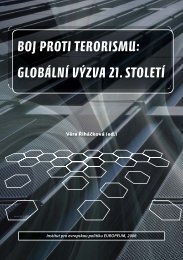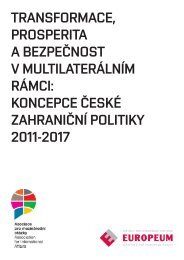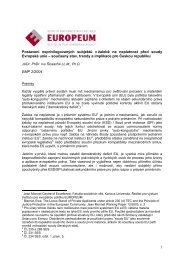eu constitutionalisation - EUROPEUM Institute for European Policy
eu constitutionalisation - EUROPEUM Institute for European Policy
eu constitutionalisation - EUROPEUM Institute for European Policy
You also want an ePaper? Increase the reach of your titles
YUMPU automatically turns print PDFs into web optimized ePapers that Google loves.
Chapter 6: A ‘saut constitutionnel’ out of an intergovernmental trap?4. PROCEDURES AND INSTITUTIONSThe following analysis of the procedures and institutions with regard to theCommon Foreign and Security <strong>Policy</strong> in the TCE is divided into two parts:In the first part, the respective general CFSP provisions will be analysed.The second part deals separately with the special provisions <strong>for</strong> security anddefence. This separation takes into account the dynamic development ofthe <strong>European</strong> Security and Defence <strong>Policy</strong> since its creation in 1999, representinga salient part of the Common Foreign and Security <strong>Policy</strong>.4.1. Procedures and institutions: CFSP4.1.1. Decision-making rules: the perennial controversy on QMVDespite intensive controversy in and around the Convention and to a lesserdegree in the IGC, the TCE has only marginally amended the rules <strong>for</strong> decision-making(Art. III-300) and has thus failed to achieve a major breakthroughto increase internal efficiency. A Franco-German project had proposedto “make decisions in the field of CFSP generally by qualified majority“³⁴.However, this initiative to water down the principle of unanimity met withresistance by a number of representatives especially from governments, aboveall from the United Kingdom, behind which others did not need to voice theiropposition³⁵. The deep rift over the participation in the Iraq war generallyreduced the propensity to accept majority voting. In view of unclear majoritiesmore and more governments became risk averse; the worry of being outvoteddue to low “policy con<strong>for</strong>mity”³⁶ spread in many capitals. Consequently, thetext continues to state that “<strong>European</strong> decisions … shall be adopted by theCouncil of Ministers acting unanimously”(Art. III-300 (1)).In addition to a small number of complex existing derogations (see Art. III-300 (1) and (2)) the new UMFA is offered a complicated opportunity to put<strong>for</strong>ward a proposal <strong>for</strong> voting by qualified majority but only on a “specificrequest” from the <strong>European</strong> Council (Art. III-300 (2b)). Also with theselimited openings the hurdle is kept high: even after a unanimous decision34) Contribution by Joschka Fischer and Dominique de Villepin to the Convention, [own translation],CONV 489/03, http://register.consilium.<strong>eu</strong>.int/pdf/de/03/cv00/cv00489de03.pdf; (German version) orCONV422/02, http://register.consilium.<strong>eu</strong>.int/pdf/fr/02/cv00/00422f2.pdf (French version) [23.11.2005].35) See e.g. JOPP and REGELSBERGER (2003) p. 556, THYM (2004), p. 11.36) See <strong>for</strong> the term KOENIG–ARCHIBUGI (2004), p. 143.208Chapter 6: A ‘saut constitutionnel’ out of an intergovernmental trap?by the <strong>European</strong> Council, every member state can reject a majority vote“<strong>for</strong> vital and stated reasons of national policy” (Art. III-300 (2)). In order tosupport the fundamental concern of nation states, the document reiteratesthat even these limited possibilities <strong>for</strong> QMV do not apply to “decisionshaving military or defence implications” (Art. III-300 (4)).The Convention’s proposal <strong>for</strong> these decision-making rules document thevictory of diplomats in general and of intergovernmentalist views morespecifically: not only have <strong>for</strong>mer intergovernmental conferences missedthe opportunity <strong>for</strong> increasing the efficiency of the procedures, but so hasalready the Convention, even in a different composition from that of diplomaticconferences. In the case of diverging opinions over external actionsof limited scope and minor impact, the constitutional treaty might haveprovided a constitutional option to overrule minority positions of memberstate governments.To a certain extent, the document takes note of such suggestions: through anempowering clause, the <strong>European</strong> Council “may unanimously adopt a <strong>European</strong>decision stipulating that the Council of Ministers shall act by a qualifiedmajority” (Art. III-300 (3)) provided though that not a single national parliamentdoes make its opposition known (Art. IV-444 (3)); generally excludedare again “decisions having military or defence implications” (Art. III-300 (4)).Through such a ‘passerelle’ the heads of government would circumvent theneed to have these revisions <strong>for</strong>mally ratified in each member state.In contrast to the basic red line, voting with qualified majorities was extendedto the nomination procedures <strong>for</strong> the fulltime President of the <strong>European</strong>Council and of the Foreign Minister, which might help to achieve a fasterconsensus.4.1.2. The institutional architecture:towards personalisation and politicisation4.1.2.1. Familiar trendsThe Convention had considerably redesigned the institutional architectureof the CFSP (see graph 1); in major features this work has been reconfirmedby the IGC.209








